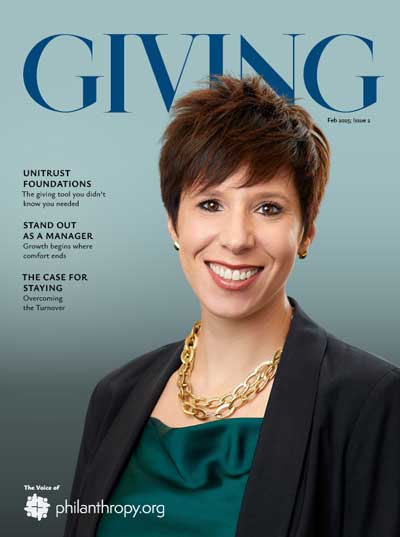Nonprofits that fail to plan for the future are in for a rude awakening. Community foundations and other grant makers (including the government)—once seen as reliable sources of funding—are becoming increasingly selective about where their money goes. And they’re not interested in propping up organizations that refuse to grow up.
Why? Because too many nonprofits have become complacent. They rely on handouts instead of building real financial resilience. The data from the past five years is clear: transactional fundraising alone is not enough to sustain an organization long-term. If you’re only thinking about your next event, your next appeal, or your next grant cycle—rather than how your organization will be thriving a decade from now—why should funders invest in you?
Planned Giving: A Litmus Test for Responsible Nonprofits
Community foundations and major donors are looking for nonprofits that understand one fundamental truth: longevity matters. And one of the best indicators of long-term thinking is whether an organization is serious about planned giving.
A nonprofit that invests in planned giving is demonstrating:
- A commitment to its future sustainability.
- A strategic mindset beyond short-term cash grabs.
- An understanding that true philanthropy is about relationships, not just transactions.
Compare that to the nonprofits that operate like financial black holes—always asking, always struggling, and never evolving. Why would a foundation want to pour money into an organization that isn’t taking steps to ensure its own survival?
Why should I care about your future if you don’t?
Complacency Should Not Be Rewarded
Too many nonprofits have coasted for too long—treating donor support as a right instead of something to earn through strategy, discipline, and a future-focused mindset.
Funders (both government and private) are no longer in the business of bailing out organizations that refuse to mature. If your nonprofit is still stuck in survival mode—lurching from one grant cycle to the next, ignoring long-term strategy—it’s already failed the test.
Maybe it’s the nature of the nonprofit world to attract people who’ve opted out of the real business arena—those more comfortable in a bubble of good intentions than in the marketplace of results.
Planned giving isn’t a side dish anymore. It’s the signal that your nonprofit is built to last. Funders want proof you’re playing the long game—and if you can’t show that, they’re moving on.
Reality Check: Recent Cuts in Federal Funding Are Weeding Out Weak Nonprofits
Love him or hate him, Trump’s administration has taken a sharp knife to government spending, especially in areas where dependency has been the norm. And while some may see this as harsh, there’s a certain economic reality at play: when funding dries up, the weak organizations—the ones that have never prioritized sustainability—will die off.
It’s like a hurricane hitting the shoreline—when the storm clears, the old, fragile structures are wiped away, making room for new, stronger foundations that can withstand the next disaster. The nonprofits that crumble were never built to last. But those that reinforce their structures—by investing in sustainability, planning ahead, and adapting—will emerge even stronger.
It’s a classic case of “survival of the fittest.” Pro-business governments tend to operate this way because history shows that strong organizations (whether in business or in the nonprofit world) will adapt, innovate, and get stronger. Those that don’t? They were never built for longevity in the first place.
If your nonprofit’s entire existence depends on government grants and emergency funding, the message is clear: you’re at risk and should be worried. The organizations that will survive (and thrive) are the ones that take a proactive approach. They are diversifying their funding sources. They are building endowments. They are investing in planned giving.
Nothing New—Donor Money Has Been Drying Up for Years
Jonathan Gudema at MajorGifts.com has been warning about this for years, and the numbers prove it. The problem isn’t just with community foundations—it’s across the board.
- Over the past four years, individual giving has declined by $65 billion, according to recent data.
- Wealthy donors are becoming more strategic and discerning about where their money goes.
- Funders aren’t just looking for passion; they want proof of sustainability and a clear vision for the future.
The free money era is over. Nonprofits that refuse to adapt will die. There are no more free rides—it’s survival of the smartest now. If your entire fundraising strategy depends on handouts and short-term appeals, you’re already on borrowed time. It’s time to stop begging and start planning.
The free money era is over. Survival of the smartest starts now.
Nonprofits Created Their Own Storm—Now They’re Crying That It’s Raining
Let’s be clear: the situation many nonprofits find themselves in today isn’t some unforeseen tragedy. It’s the direct result of years of short-term thinking, poor financial planning, and an overreliance on easy money.
For decades, many organizations have operated as if the funding faucet would never run dry—chasing grants, relying on government handouts, and treating donors like ATM machines rather than long-term partners. Instead of building reserves, endowments, or planned giving programs, they doubled down on the same broken model.
Now that the tide is turning and foundations are demanding sustainability, these same nonprofits are crying foul. But they shouldn’t be surprised. They created their own storm. Now they’re upset that it’s raining.
The nonprofit sector isn’t much different from the failures of our welfare system. For decades, we’ve seen that simply handing people money without requiring self-sufficiency doesn’t improve their situation—it just creates permanent dependency. The same goes for nonprofits. When organizations rely too heavily on grants and government support, they don’t build the skills, strategy, or financial foundation needed to survive on their own. Helping those who refuse to help themselves has never worked—and it never will.
The truth? The nonprofits that suffer the most in times of economic tightening are the ones that refused to prepare. And that’s nobody’s fault but their own.
Helping those who refuse to help themselves has never worked—and it never will.
Funders Want to Support Survivors, Not Dependents
Community foundations and Grantmakers aren’t charities for charities. They are strategic investors in the nonprofit sector. And like any good investor, they want to back organizations with a clear future.
If your nonprofit is only interested in the next grant cycle, rather than the next generation, you are signaling to funders that you don’t have a plan. And if you don’t have a plan, you don’t deserve their money.
And if you still plan to rely on grants, you better work with a grant writer who is the best of the best. You will need her. Because competition for funding is tighter than ever, and foundations are no longer handing out money to just anyone with a mission statement.
Planned giving isn’t optional anymore. It’s the price of admission for serious, sustainable nonprofits.
Planned giving is no longer optional. It’s the non-negotiable price of admission for a sustainable future.







I’m grateful for your commonsense thinking on this subject. I have received numerous emails from other fundraising professionals and organizations lamenting the actions being taken by President Trump and DOGE. I am concerned about the way my tax dollars are being used by organizations that don’t hold themselves accountable for growing their donor base and instead rely heavily on government funding.
I wish I’d had this article to hand to the organizational leadership when I was still working as a Development Director. I spent years singing the “Planned Giving” song, trying to make the case for long-term investment, but they were always hesitant to “draw resources” (translation: allocate my time and cover launch costs) to build something that didn’t yield immediate returns. It was frustrating and shortsighted.
You’re absolutely right that funders aren’t necessarily asking for fully formed planned giving programs, but they are laser-focused on sustainability. I’ve seen this play out time and again in how grantmakers evaluate proposals, not just for what an organization is doing now, but for how it’s preparing for future resilience. Increasingly, they’re rewarding organizations that show a strategic mindset. Those that collaborate, plan for succession, build infrastructure, and diversify their funding base are winning the awards.
Planned giving is a critical piece of that sustainability puzzle, but it can’t stand alone. In my experience funders are also looking for:
• Revenue diversity – Organizations that aren’t overly reliant on a single grant, gala, or government stream.
• Collaborative models – Strategic partnerships that reduce duplication and increase impact.
• Operational reserves and endowments – Even modest ones signal planning and fiscal health.
• Strong donor stewardship – Not just acquisition, but relationship-building and long-term retention.
• Strategic leadership – Boards and execs who think beyond the fiscal year.
• Proactive planning – Multi-year budgets, contingency strategies, and measurable goals.
To me, the heart of this article is about moving from reactive to intentional. Planned giving is just one way to plant roots and it’s clear to me that funders are done investing in organizations that act like tumbleweeds.
And from a consulting perspective? The more strategically-minded organizations who are actively working toward long-term sustainability tend to offer more serious, substantive engagements. They understand the value of investing in planning, systems, and fundraising infrastructure, and they’re often more receptive to high-level strategy consulting, including planned giving, capital campaign planning, and funding diversification.
On the flip side, organizations operating in crisis mode or stuck in a scarcity mindset tend to view consultants as a short-term fix. They’re more likely to ask for a one-off grant proposal or expect magic without internal alignment or infrastructure. These engagements are often transactional, and frankly, less fulfilling.
With the economy becoming more cutthroat, I think this is really relevant right now. There are thousands and thousands of nonprofits out there competing for funding, so unfortunately, the only ones who will succeed are the ones that plan for long-term survival.
But if we get more specific on HOW to do what the article is talking about (be more future-focused and prove that to your funders), I think nonprofits need to focus more on building systems. Which means building systems within their organization and in the community.
So some examples of what that looks like would be: Do you have a system to check in on donors regularly instead of simply talking when you have a spare day? Did you create a system for collecting data throughout the year instead of putting together what’s available at the end of the year? (If you donate clothes for example:) Did you invest funds into building a pre-planned network of clothes suppliers, delivery systems, and delivery schedules instead of allocating time and money into planning new delivery trips every time a new donation comes in from random donors?
It’s systems like these that show funders that you’re serious.